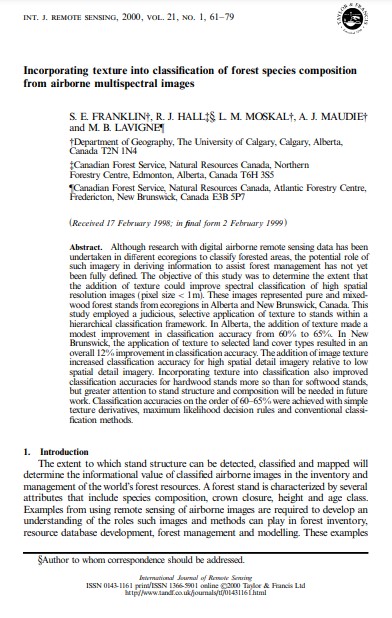Incorporating texture into classification of forest species composition from airborne multispectral images
Bosque Modelo:
Fundy
Temática:
Gestión forestal
Tipo de documento:
Artículo científico
Resumen
Although research with digital airborne remote sensing data has been undertaken in different ecoregions to classify forested areas, the potential role of such imagery in deriving information to assist forest management has not yet been fully defined. The objective of this study was to determine the extent that the addition of texture could improve spectral classification of high spatial resolution images (pixel size <1m). These images represented pure and mixed-wood forest stands from ecoregions in Alberta and New Brunswick, Canada. This study employed a judicious, selective application of texture to stands within a hierarchical classification framework. In Alberta, the addition of texture made a modest improvement in classification accuracy from 60% to 65%. In New Brunswick, the application of texture to selected land cover types resulted in an overall 12% improvement in classification accuracy. The addition of image texture increased classification accuracy for high spatial detail imagery relative to low spatial detail imagery. Incorporating texture into classification also improved classification accuracies for hardwood stands more so than for softwood stands, but greater attention to stand structure and composition will be needed in future work. Classification accuracies on the order of 60-65% were achieved with simple texture derivatives, maximum likelihood decision rules and conventional classification methods.
Información Bibliográfica
Autor:
Franklin, S.E., Hall, R.J., Moskal, L.M., Maudie, A.J., & Lavigne, M.B.
Revista:
International Journal of Remote Sensing
Año:
2000
N°:
1
País :
Canadá
Páginas:
61 - 79
Volumen:
21
Idioma:
Ingles
Palabras claves
Forest inventory Habitat assessment Land cover Map quality Remote sensing Resource selection analysis





